
Unboxing the Barriers to Scaling up Electric Bus Adoption in India
Electric buses (e-buses) are steadily coming into focus as an answer to clean public transport. Currently, about 18 lakh buses are plying on Indian roads of which 92% are privately owned and just 8% publicly owned. At the existing ridership India requires about 460,000 buses by 2031 and COVID-19 social distancing norms will further bump up the bump up the demand by 30% or at least 600,000 buses.
In this blog, which is a part of the TCO (Total Cost of Ownership) blog series, we discuss the cost of owning and operating e-buses in comparison to their Internal Combustion Engine (ICE) counterparts.
Supportive government initiatives
State Road Transport Undertakings (SRTUs) have been an early adopter of e-buses in India. Under the two phases of the Faster Adoption and Manufacturing of (Hybrid &) Electric Vehicles (FAME) scheme, 390 e-buses (FAME I in 2015) and 2,450 e-buses (FAME II in 2019-20) were approved by the Government of India. More than 80% e-buses tendered out under FAME-II and 65% of FAME-I e-buses were 9m Midi buses (see Figure 1).
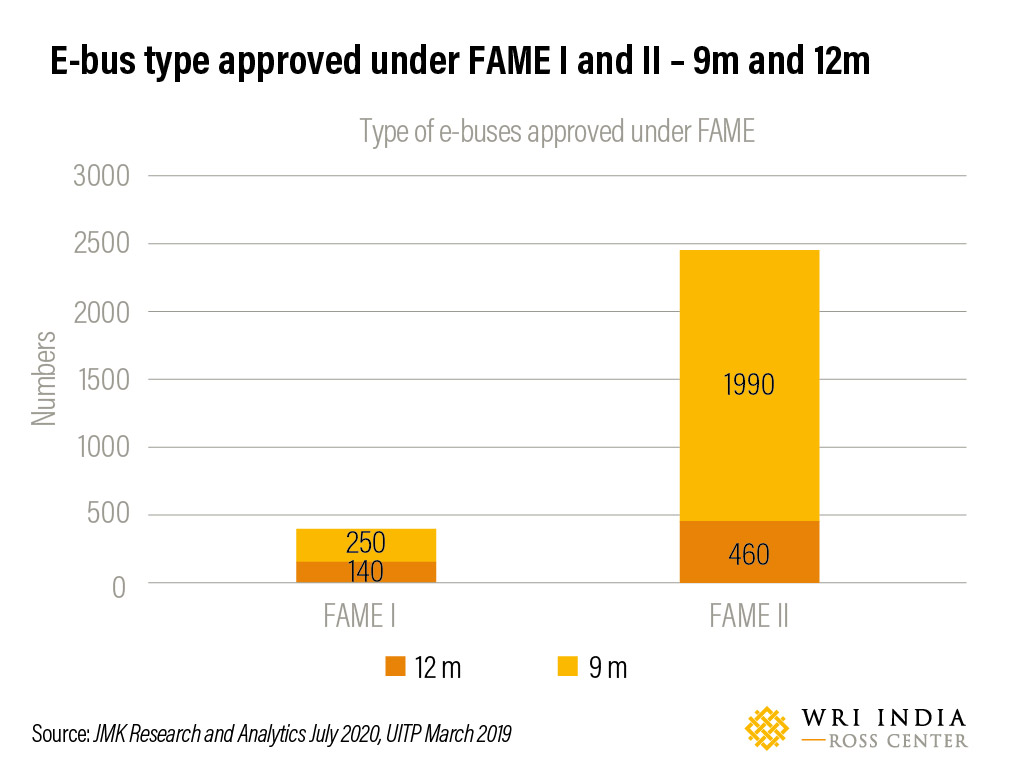
Around 70% of e-buses procured under FAME-1 scheme were on outright purchase, whereas remaining were on Gross Cost Contract (GCC). A considerable variation in technical specification as well as bid rates for buses purchased under both procurement models was seen. This prompted the Department of Heavy Industry (DHI) to carry out a benchmarkingof prices of various e-bus configurations for availing financial incentives. Correspondingly, GCC model was mandated to avail FAME II incentives. Insights from the TCO analysis can help in the developing innovative business models for e-buses.
Economic viability of e-buses: Insights from TCO analysis
We compared the TCO per kilometre of a 12m e-bus with its ICE variants: 12m AC high-cost diesel bus (Diesel-HC Bus), low-cost diesel bus (Diesel-LC Bus) and 12m CNG-bus at an average daily travel distance of 200 kilometre. Figure 2 shows that the TCO/km of a 12m e-bus (INR 64.46/km) is lower than the Diesel-HC bus, but higher than Diesel-LC and CNG-bus. By applying FAME II subsidy of INR 50 Lakh (Approx. USD 68,500) to the current capital cost conditions, the TCO/km of the e-bus comes down to around INR 54/km. By reducing battery capacity (320 kWh to 125 kWh), and deployment of one fast charger for three e-buses instead of a slow charger per bus, the TCO/km of e-bus decreases further to INR 44/km.
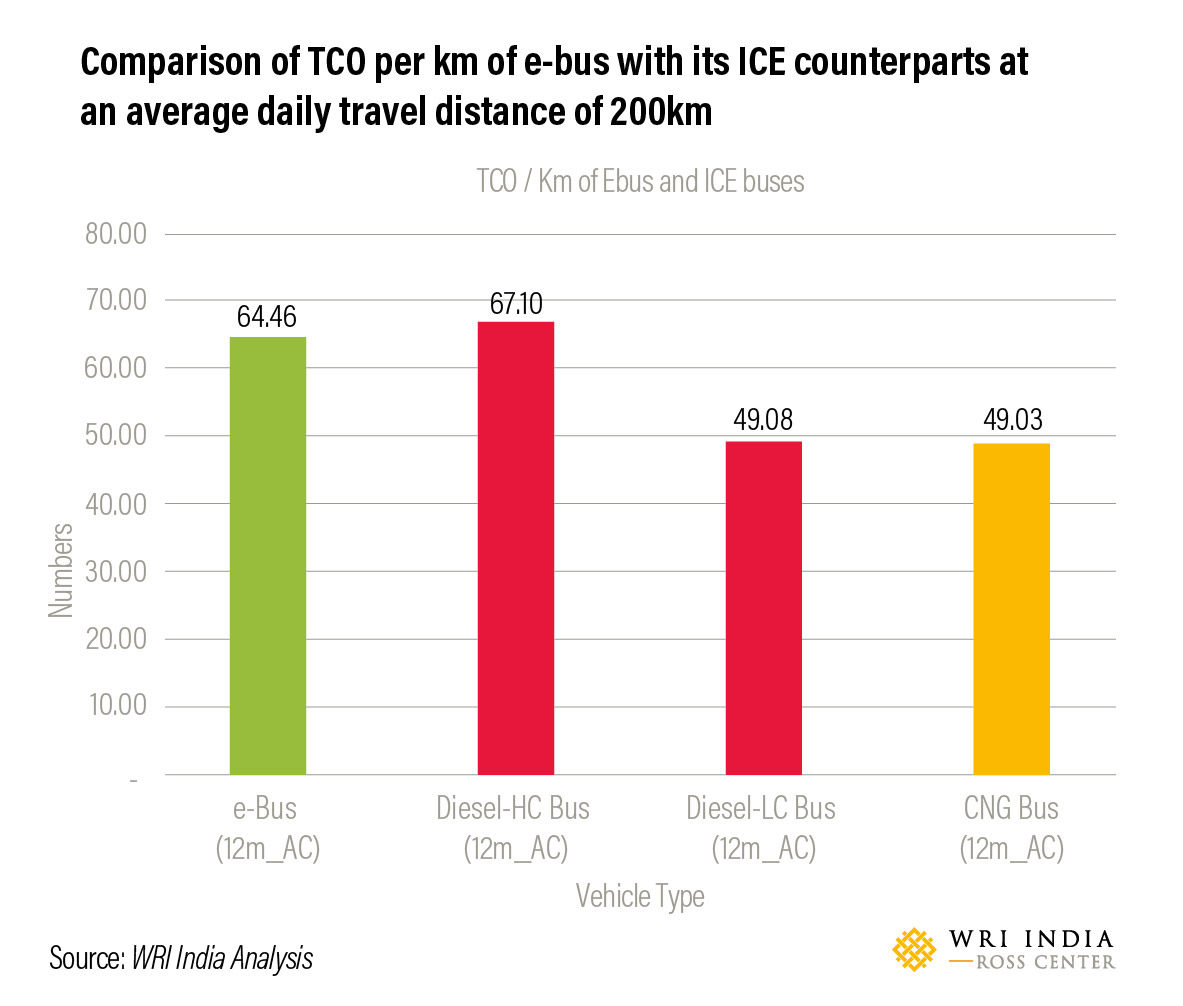
Figure 3 shows the effect of vehicle utilisation on TCO/km of an e-bus and its ICE counterparts. As the daily utilisation of the e-bus increases, the TCO/km gap between an e-bus and its ICE counterparts decreases.
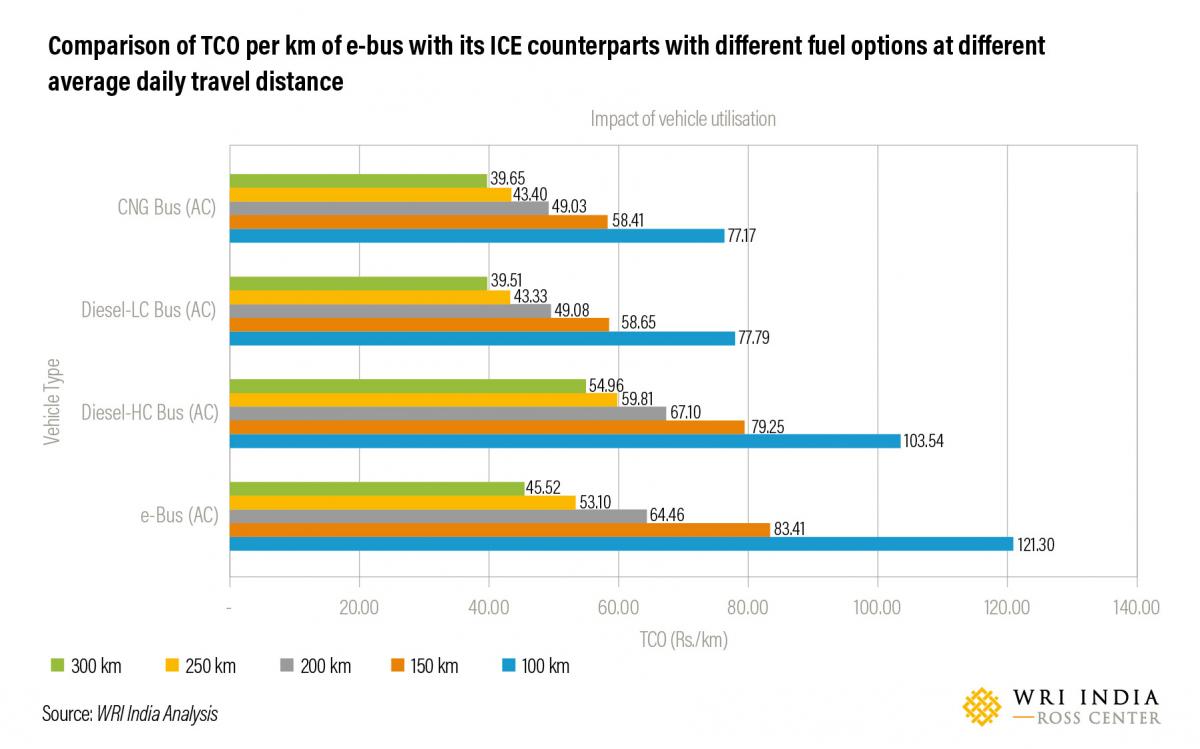
While comparing the year-wise TCO/km (see Figure 4), for an average daily travel distance of 200 km, the TCO/km of an e-bus becomes less than that of a Diesel-HC bus at the sixth year of holding period (period for which bus is in service, taken as 10 years for the analysis). With increase in vehicle holding period, the gap in TCO/km of an e-bus and its ICE counterparts decreases significantly. With higher vehicle utilisation and reduced purchase cost, the TCO/km of an e-bus is comparable to that of its ICE counterparts at an earlier stage during the holding period. For example, at a daily utilisation of 250 km, TCO/km of e-bus intercepts that of Diesel-HC bus at the third year itself and wears off.
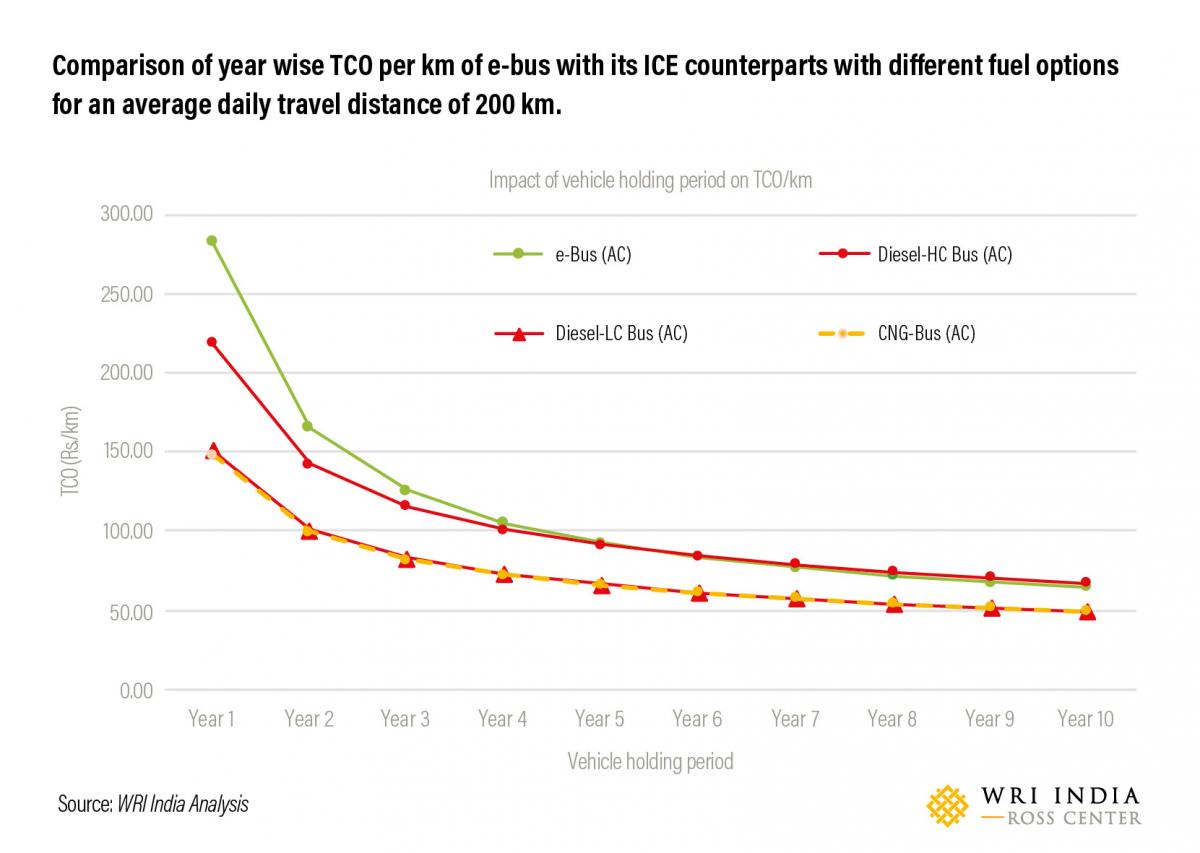
As most e-buses approved under the FAME I and II were 9m, we compared the TCO/km of the 9m e-bus with its ICE counterparts (see Figure 5). For an average daily travel distance of 200 km, the TCO/km of e-bus is higher than its ICE counterparts. Similar to the 12m e-bus, the gap in TCO/km decreases with increase in vehicle utilisation, vehicle holding period and decrease in purchase cost of the e-bus.
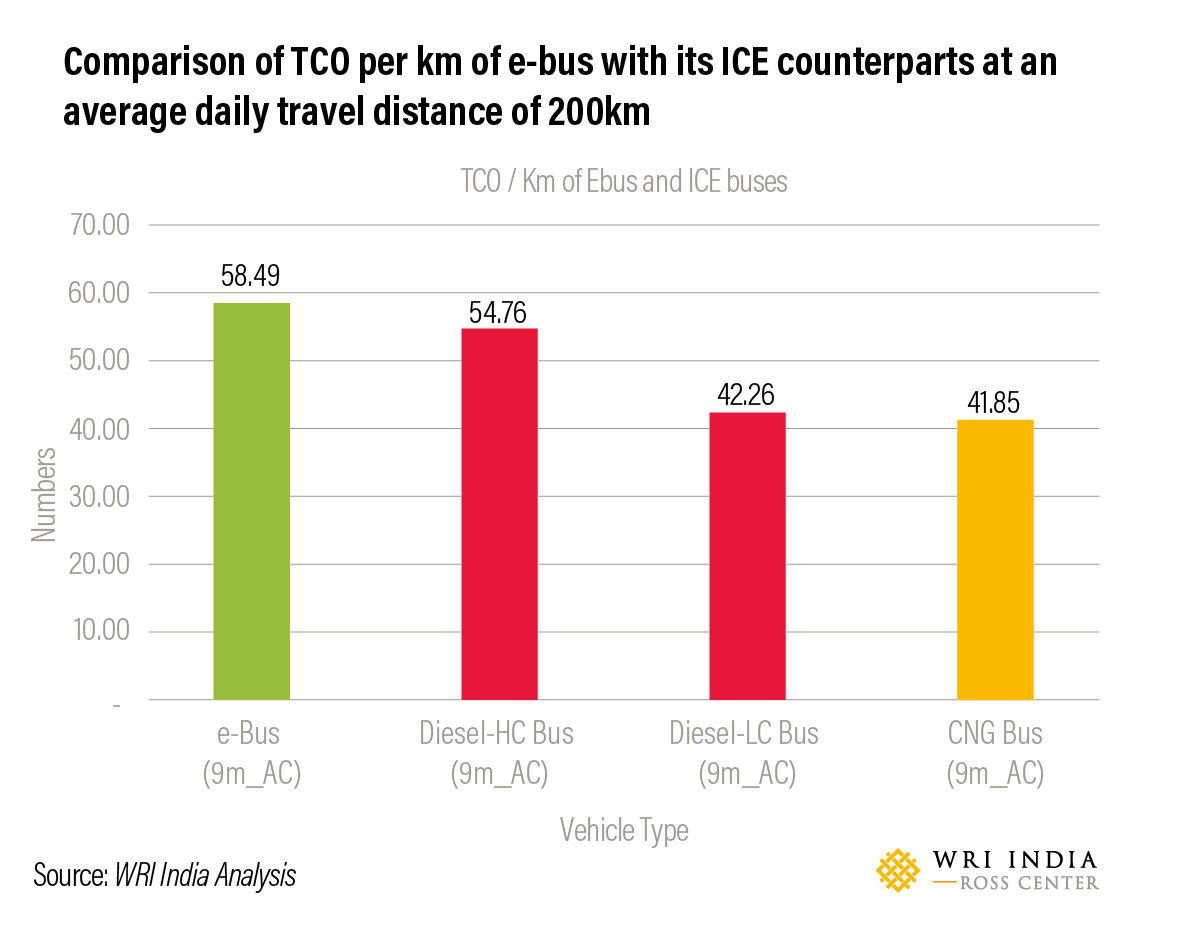
Innovation in E-bus Procurement Models
Generally, three types of procurement and operating models are explored by various transit agencies: Gross Cost Contract (GCC), Outright purchase models and Battery Leasing models.
GCC - The ownership, operating and maintenance risk of e-buses are borne by private operators, while operational schedule and farebox revenues are owned by transit agencies.
Outright purchase model - The responsibilities of owning and operations are handled by the transit agencies themselves, increasing the anxiety of risk associated with the new technology and cost of acquisition.
Battery leasing model - Reduces upfront cost by dividing the risk of owning the bus and the battery between the transit agency and battery service provider respectively. This reduces the upfront purchase cost by 30-40%, while the battery cost gets recovered over the lease period.
Innovative financing mechanisms and a robust legal framework for sharing risks and effective use of resources can help accelerate e-bus adoption. For example, the the e-bus procurement model, adopted by Shenzhen (China) includes financial leasing, separation of owning both vehicle and battery, and integration of charging and maintenance. This model reduces the cash flow pressure and financial burden on transit agencies.
Key Recommendations
The e-bus market, in India, is still at a nascent stage and recent policy measures suggest a strong future. During the early stages of e-bus adoption, the GCC model will help State Road Transport Undertakings in understanding the facets of e-bus deployment with reduced risks. This TCO analysis identifies vehicle utilization, capital cost optimization, and vehicle holding period as the most crucial variables for effective transition to e-buses. Conducting a detailed Total Cost of Ownership (TCO) analysis analysis helps stakeholders optimise the parameters which will define procurement models, devise effective operations and deployment of e-buses.
This is the fifth blog in a series on TCO analysis of electric vehicles in the Indian market. The blog series seek to demystify the total costs of owning and operating EVs for individuals and fleet operators, analyze the role of financial incentives and vehicle utilization patterns, and highlight specific implications for policy makers and manufacturers.
Read our first blog in this series here.
Views expressed here are the authors’ own.